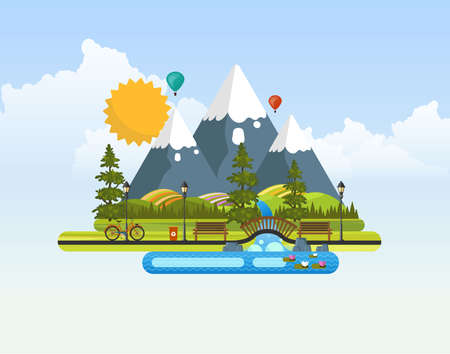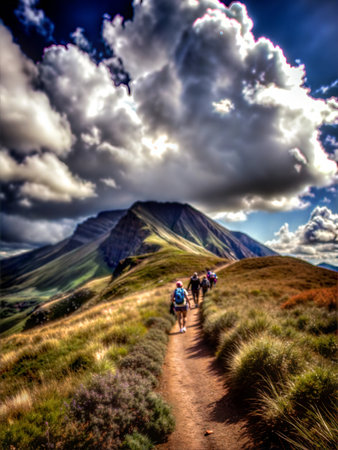1. Introduction: The Rise of Virtual Hiking
In recent years, the landscape of outdoor adventure in the United States has undergone a fascinating transformation. Thanks to advancements in technology and social connectivity, virtual hiking challenges and online hiking groups have surged in popularity, drawing together individuals from all walks of life. These digital platforms bridge the gap between people who may be separated by geography, fitness levels, or busy schedules, yet share a common love for nature and exploration. Whether you’re living in a bustling city or a quiet suburb, virtual hiking communities offer a new way to experience America’s great outdoors—right from your own neighborhood or even your living room. This growing movement is not only making outdoor recreation more accessible but also fostering meaningful connections among participants nationwide. As we embark on this journey “From Couch to Trailhead,” let’s explore how virtual hiking is reshaping the way Americans engage with nature and each other.
Motivation Beyond the Trail: Psychosocial Benefits
Virtual hiking challenges have transformed how people interact with the outdoors, especially for those who might not have immediate access to scenic trails. These digital experiences go far beyond simply logging steps or accumulating miles; they offer powerful psychosocial benefits that can start at home and extend well before anyone sets foot on a physical trail.
Igniting Participation from Home
One of the most impressive aspects of virtual hiking is its ability to inspire participation regardless of fitness level, location, or schedule. By setting achievable goals and providing virtual badges or rewards, these programs turn everyday walks into meaningful milestones. This creates a sense of accomplishment and encourages individuals who might otherwise be intimidated by traditional outdoor activities to get moving.
Mental Health Boosts
Engagement in virtual hiking groups can lead to noticeable improvements in mental health. The anticipation of reaching a new virtual summit or completing a themed challenge provides positive distractions from daily stressors. Participants often report reduced anxiety, increased motivation, and an overall uplifted mood, similar to the effects of actual time spent in nature.
Common Mental Health Benefits Reported by Virtual Hikers
| Benefit | Description |
|---|---|
| Stress Reduction | Daily movement and goal tracking help ease tension and encourage relaxation. |
| Improved Mood | Celebrating progress with others boosts happiness and motivation. |
| Increased Self-Esteem | Earning badges or completing challenges builds confidence in one’s abilities. |
| Social Connection | Joining groups fosters belonging and reduces feelings of isolation. |
Building Community Before Hitting the Trailhead
Perhaps one of the greatest impacts of virtual hiking communities is their ability to bring people together long before anyone meets at an actual trailhead. Through online forums, social media groups, and app-based message boards, participants share stories, exchange tips, and celebrate achievements. This sense of camaraderie helps break down barriers and makes outdoor adventure feel more accessible for everyone.
The Ripple Effect: From Virtual to Real-Life Adventure
The support and encouragement found in these communities often inspire members to plan real-life hikes together, creating lasting friendships and further promoting healthy lifestyles. In this way, virtual hiking serves as both a launching pad for personal growth and a bridge connecting people to nature—and to each other—across the country.

3. Going the Distance: Physical Health Impacts
Virtual hiking challenges are transforming the way Americans approach physical fitness, making exercise more accessible and motivating for everyone from beginners to seasoned outdoor enthusiasts. By leveraging technology and community support, these programs help participants set tangible goals—like reaching a certain number of steps or “climbing” a famous mountain—while allowing them to progress at their own pace, whether they’re in urban apartments or rural neighborhoods.
One of the most significant benefits is the encouragement of regular exercise. Virtual hiking groups often use mobile apps or online platforms to track participants’ progress, send reminders, and celebrate milestones. These features foster accountability and consistency, two key factors in developing lasting healthy habits. For many Americans who struggle to fit traditional gym visits into busy schedules, virtual challenges offer a flexible and engaging alternative that can be integrated into daily life.
Beyond just moving more, goal-setting in virtual hiking fosters a growth mindset. Participants learn to break down ambitious objectives—such as walking the equivalent distance of the Appalachian Trail—into manageable daily or weekly targets. This process not only builds endurance and strength but also boosts self-confidence as individuals witness their steady improvement over time.
Importantly, virtual hiking is inclusive of all ages and fitness levels. Whether you’re a retiree looking for gentle activity or a college student seeking adventure from campus grounds, these programs adapt to your needs. Many groups offer beginner-friendly challenges and provide educational content on proper stretching, hydration, and injury prevention, reinforcing safe and sustainable practices.
The ripple effect extends beyond individual health: as participants share their achievements within virtual communities or on social media, they inspire friends and family to join in. This collective enthusiasm creates a culture where movement is celebrated rather than dreaded, supporting the larger American goal of combating sedentary lifestyles and chronic diseases like obesity and diabetes.
4. Community and Connection: Finding Your Trail Family
One of the most remarkable aspects of virtual hiking challenges and groups is their ability to foster a sense of community and belonging, especially for people who might feel hesitant about traditional outdoor activities. Online hiking communities create supportive spaces where everyone—regardless of skill level, background, or physical ability—can connect, share experiences, and motivate each other. Unlike in-person hiking clubs that may sometimes feel exclusive or intimidating, virtual groups are designed to be open and inclusive. Through group chats, forums, and social media pages, participants can celebrate milestones together, exchange tips for gear or local trails, and offer encouragement when someone hits a rough patch.
The Support System of Virtual Hiking Groups
| Feature | How It Builds Community |
|---|---|
| Online Discussion Boards | Offer a space to ask questions and share advice without judgment |
| Group Challenges | Create shared goals and friendly competition that bond members together |
| Virtual Meetups & Check-Ins | Allow hikers from all over the country to connect and encourage one another |
| Story Sharing Threads | Build empathy through personal journey posts and photos |
Inclusivity at Every Step
For many Americans, traditional hiking groups can feel unwelcoming due to factors like age, race, gender identity, body type, or lack of experience. Virtual hiking communities often go the extra mile to ensure everyone feels valued. Moderators set clear ground rules about respect and positivity. Many groups offer special threads or subgroups for parents with young kids, LGBTQ+ hikers, people with disabilities, or those starting out on their fitness journey. This diversity not only enriches the overall experience but also reflects the true spirit of America’s outdoors: wild places meant for everyone.
A Trail Family for All
Ultimately, these online connections often evolve into genuine friendships—a “trail family” that cheers you on whether you’re logging miles on city sidewalks or scaling mountain switchbacks. For those who once felt left out or unsure about joining the outdoor scene, virtual hiking challenges turn solo steps into shared adventures. With support just a message away, more people than ever before are lacing up their shoes and heading from couch to trailhead—together.
5. Nature in the Digital Age: Education and Awareness
Virtual hiking challenges have become more than just a fun way to log steps or miles; they are powerful platforms for environmental education and awareness, especially within the context of Americas diverse natural landscapes. Through interactive apps, curated content, and themed group discussions, participants are introduced to the geology, wildlife, and cultural history of iconic places like Yosemite, the Appalachian Trail, or the Grand Canyon—even while exploring these trails virtually from their living rooms.
Exploring American Landscapes Digitally
Many virtual hiking programs incorporate educational milestones along the digital trail. As users reach certain points—say, the summit of Mount Rainier or a section of the Pacific Crest Trail—they unlock facts about native species, climate zones, and Indigenous histories tied to those regions. This approach not only brings each location to life but also deepens participants’ appreciation for America’s ecological richness.
Promoting Conservation Values
Virtual hiking groups often partner with conservation organizations to highlight pressing environmental issues such as habitat loss, wildfire prevention, and invasive species control. Through blog posts, webinars, and social media campaigns, hikers learn how their actions—both online and on actual trails—can support conservation efforts. Many challenges encourage fundraising for national parks or local land trusts, making stewardship an integral part of the experience.
Responsible Stewardship Beyond the Screen
The ethos of “Leave No Trace” is woven into many virtual challenge guidelines. Participants receive tips on responsible recreation that extend beyond digital boundaries—like respecting wildlife corridors, minimizing plastic waste, and supporting sustainable tourism. These lessons help nurture a community of environmentally conscious hikers who carry their new knowledge into real-world adventures.
In this way, virtual hiking challenges bridge the gap between digital engagement and tangible stewardship. By combining innovative technology with rich educational content tailored to American nature and values, these programs inspire a new generation to care for the nation’s wild spaces—even before setting foot on an actual trail.
6. From Screen to Green: Transitioning to Real Trails
As digital engagement with virtual hiking challenges and online groups grows, a fascinating shift is taking place—from screens to the great outdoors. Many Americans who once only scrolled through breathtaking trail photos on social media or competed in step challenges from their living rooms are now lacing up their boots for real-life adventures. The sense of accomplishment earned by completing virtual hikes often plants a seed of curiosity about local parks and trails. This transition is fueled by encouragement from online communities, where members share not just their digital milestones, but also stories of their first steps onto actual dirt paths.
Social media platforms and hiking apps have become more than just places to track progress; they’re launchpads for outdoor exploration. Features like interactive maps, trail reviews, and safety tips give new hikers the confidence to explore unfamiliar terrain. Virtual badges and friendly competition spark motivation, but it’s the promise of fresh air, scenic views, and the satisfaction of overcoming real-world obstacles that truly inspires people to get outside.
Local park systems and recreation departments are noticing the trend as well. Many now partner with digital platforms to promote community events or offer guided hikes that welcome those making their first transition from virtual to physical trails. These programs often highlight accessible routes, family-friendly hikes, and even beginner workshops—ensuring that everyone feels included, regardless of experience level.
The movement from screen to green isn’t just about fitness; it’s about rediscovering a connection with nature and one’s own neighborhood. For many Americans, these first steps beyond the front door open up a world of discovery—whether it’s spotting native wildlife, learning about local ecosystems, or simply enjoying the peace that comes from unplugging for a while. In this way, digital engagement serves as a bridge, turning passive interest into active participation and transforming virtual hikers into real-life trailblazers.
7. Looking Ahead: The Future of Virtual Outdoor Communities
The intersection of technology and in-person trail use is poised to shape the future of American outdoor culture in exciting new ways. As virtual hiking challenges and online groups become more sophisticated, we can expect to see innovations that further bridge the gap between digital platforms and real-world adventure. Augmented reality (AR) apps may soon overlay educational content on your phone as you hike, offering instant plant identification or highlighting local wildlife conservation efforts, deepening the connection between hikers and their environment.
Wearable technology will likely evolve beyond simple fitness tracking, providing real-time safety updates, weather alerts, and even community-sourced trail conditions. These advancements can empower both novice and experienced hikers to explore with greater confidence, while staying connected to a supportive network. Imagine participating in a nationwide challenge where your progress unlocks virtual badges, contributes to conservation donations, or connects you with fellow hikers at local meetups—blending digital motivation with tangible impact.
For the next generation of outdoor enthusiasts, these tools will transform how they discover trails, learn about ecosystems, and foster stewardship for Americas natural spaces. Virtual communities are already democratizing access to hiking information and peer support; as technology advances, this inclusivity will only grow stronger. The lines between “virtual” and “real” will blur, inspiring more Americans to move from their couches to trailheads—and from solo adventurers to active members of a vibrant outdoor community.


